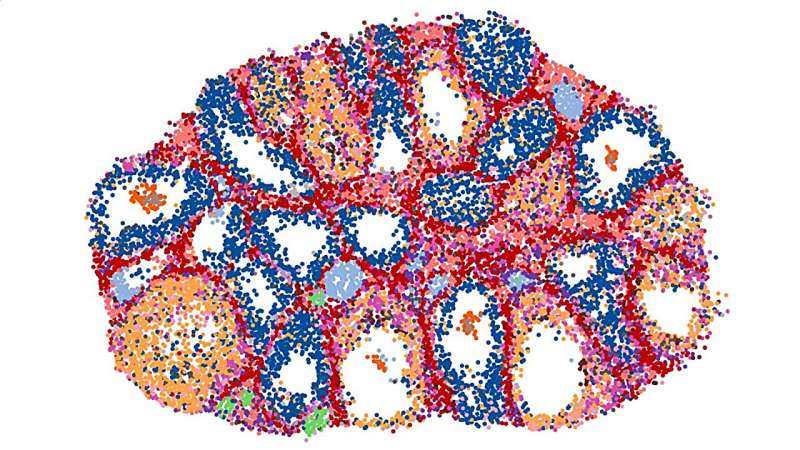This article has been reviewed according to Science X's editorial process and policies. Editors have highlighted the following attributes while ensuring the content's credibility:
fact-checked
peer-reviewed publication
trusted source
proofread
Gene expression atlas captures where ovulation can go awry

An interdisciplinary collaboration has used a cutting-edge form of RNA tagging to map the gene expression that occurs during follicle maturation and ovulation in mice.
The resulting atlas reveals a slew of previously unknown cellular and molecular interactions that drive ovulation, which is crucial for female fertility. The findings could prove pivotal for developing therapeutic treatments for infertility.
The research, published Jan. 22 in Proceedings of the National Academy of Sciences, was led by Iwijn De Vlaminck, associate professor of biomedical engineering in Cornell Engineering, and Yi Ren, assistant professor of animal science in the College of Agriculture and Life Sciences. The paper's lead author is Madhav Mantri, Ph.D., now a postdoctoral researcher at Stanford University.
De Vlaminck had previously used the imaging method, high-resolution spatiotemporal transcriptomics, to survey the entire spectrum of RNA in mouse tissues, which showed the role of elusive RNA in skeletal muscle regeneration and viral myocarditis. Transcriptomics essentially converts RNA into DNA copies, which are tagged with barcodes that capture their spatial location—data that can then be sequenced into an image.
In 2022, De Vlaminck gave a presentation on the myocarditis findings at the 2nd Intercampus Immunology Symposium, which Ren attended. She was intrigued by De Vlaminck's approach and wondered if it could be applied to one of her chief interests: unraveling the cellular and molecular mechanisms that regulate ovulation.
Ovulation requires accurate coordination between female germ cells, called oocytes, and their release via the rupture of ovarian follicles, which provide the environment for oocytes to grow and mature. In mice, this rupture occurs every four to five days; in women, it's approximately every four weeks. Oocytes expire quickly once they depart the ovary, so the timing of their release is critical.
"Ovarian follicles are like launching pads, and the ovary is like the ground control. Together they prepare the eggs for fertilization at the right time and right location," Ren said. "All the different cell types in the ovary must work together through an amazingly complex and dynamic 'social network' that involves intricated communication between all cells. That's the power of Iwijn's technology. It combines high resolution in both time and space. So those two really capture the essence of ovulation."
In the years since De Vlaminck's myocarditis study, the spatial resolution of transcriptomics has significantly improved, from 100 micrometers to 10 microns per pixel—a tenfold enhancement that has resulted in near single-cell resolution. The flip side to obtaining so much data, however, is that parsing it all is daunting.
"We had about 10 images and we spent a good 10 months making sense of them," De Vlaminck said.
For each image, the researchers sequenced hundreds of millions of DNA molecules, then translated them into a matrix of gene expression. Every pixel contained the expression level of all 22,000 protein-coding genes in the mouse genome. The next step was to multiply that by approximately 100,000 pixels. And that was only the beginning.
"You have to turn that data into biological findings, look at temporal patterns, fish out specialized cell states and so on," De Vlaminck said. "It's not just like a normal microscopy image where you have the image, and that's it, you see what you see."
Among the findings, the atlas reveals that roughly one hour before an egg is released, the follicles undergo an additional layer of selection to determine which ones will ovulate. This acute process had never been identified before, and when it goes awry, it may lead to reduced ovulation rates and could hinder fertility. The researchers were also able to detect early differentiation markers that decide the different paths cells may take in the ovary. In effect, the atlas captures dynamic cellular and molecular control programs in both the very early and very late stages of ovulation.
"This type of atlas provides so much more detail about where and when all the molecular changes happen in the ovary, details that were difficult to capture using other methodologies," De Vlaminck said. "So that may inspire new interventions that target specific molecules we identify, for example, specific genes that are important for fertility management."
Now De Vlaminck and Ren, who are both faculty with the Cornell Reproductive Sciences Center, plan to extend their collaboration into exploring fertility and ovulation problems associated with obesity and reproductive aging.
In the U.S. alone, more than 10% of infertility cases are caused by ovulation failure, the researchers noted, a problem that is exacerbated by increasing obesity, and maternal age.
"There is a growing interest at Cornell in these types of problems, where we can use cutting-edge engineering principles for reproductive medicine—an area where those cutting-edge tools are not used as much, or as early, as in some other fields, like cancer biology, for instance," De Vlaminck said.
Co-authors include doctoral student Hanxue Hannah Zhang and Emmanuel Spanos.
More information: Madhav Mantri et al, A spatiotemporal molecular atlas of the ovulating mouse ovary, Proceedings of the National Academy of Sciences (2024). DOI: 10.1073/pnas.2317418121
















